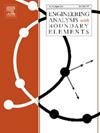Simulation analysis of detonation wave propagation in explosive with multiple initiation points by generalized Interpolation material point method
IF 4.2
2区 工程技术
Q1 ENGINEERING, MULTIDISCIPLINARY
Engineering Analysis with Boundary Elements
Pub Date : 2024-11-21
DOI:10.1016/j.enganabound.2024.106044
引用次数: 0
Abstract
In the research of explosion shock theory and engineering application, the convergence of detonation waves can be realized by using multiple initiation points to utilize the detonation energy and pressure effectively. To study the propagation process of detonation wave and the distribution law of impact energy of the explosive with multiple initiation points, a detonation calculation model of the explosive with multiple initiation points is constructed using an improved material point method, namely the generalized interpolation material point (GIMP) method. Meanwhile, two-dimensional and three-dimensional numerical simulations are given on detonation wave propagation and convergence processes in explosives with multiple initiation points. The process of detonation wave formation and convergence is simulated by Wuji Particle Dynamics (WP-DYNA) software, and the dynamic changes of physical parameters such as detonation pressure, product density, and internal energy are analyzed in detail. To verify the accuracy of numerical simulation, corresponding explosive detonation experiments are carried out; the simulation results are compared with the ultra-high speed photoelectric framing photography and the aluminum ingot double detonating cord experiment. The results show that the generalized interpolation material point method has good stability and relatively high calculation accuracy when simulating explosive detonation waves. A robust numerical calculation tool can be provided for the practical application of explosive detonation.
用广义插值材料点法模拟分析多起爆点炸药中的爆轰波传播
在爆炸冲击理论和工程应用研究中,利用多起爆点可以实现爆轰波的收敛,有效利用爆轰能量和压力。为研究多起爆点炸药的起爆波传播过程和冲击能量分布规律,采用改进的材料点法,即广义插值材料点法(GIMP),构建了多起爆点炸药的起爆计算模型。同时,对多起爆点炸药的起爆波传播和收敛过程进行了二维和三维数值模拟。利用无极粒子动力学(WP-DYNA)软件模拟了起爆波的形成和收敛过程,并详细分析了起爆压力、产品密度和内能等物理参数的动态变化。为验证数值模拟的准确性,进行了相应的炸药起爆实验,并将模拟结果与超高速光电取景摄影和铝锭双导爆索实验进行了对比。结果表明,广义插值材料点法在模拟爆炸起爆波时具有良好的稳定性和较高的计算精度。为爆炸起爆的实际应用提供了可靠的数值计算工具。
本文章由计算机程序翻译,如有差异,请以英文原文为准。
求助全文
约1分钟内获得全文
求助全文
来源期刊

Engineering Analysis with Boundary Elements
工程技术-工程:综合
CiteScore
5.50
自引率
18.20%
发文量
368
审稿时长
56 days
期刊介绍:
This journal is specifically dedicated to the dissemination of the latest developments of new engineering analysis techniques using boundary elements and other mesh reduction methods.
Boundary element (BEM) and mesh reduction methods (MRM) are very active areas of research with the techniques being applied to solve increasingly complex problems. The journal stresses the importance of these applications as well as their computational aspects, reliability and robustness.
The main criteria for publication will be the originality of the work being reported, its potential usefulness and applications of the methods to new fields.
In addition to regular issues, the journal publishes a series of special issues dealing with specific areas of current research.
The journal has, for many years, provided a channel of communication between academics and industrial researchers working in mesh reduction methods
Fields Covered:
• Boundary Element Methods (BEM)
• Mesh Reduction Methods (MRM)
• Meshless Methods
• Integral Equations
• Applications of BEM/MRM in Engineering
• Numerical Methods related to BEM/MRM
• Computational Techniques
• Combination of Different Methods
• Advanced Formulations.
 求助内容:
求助内容: 应助结果提醒方式:
应助结果提醒方式:


